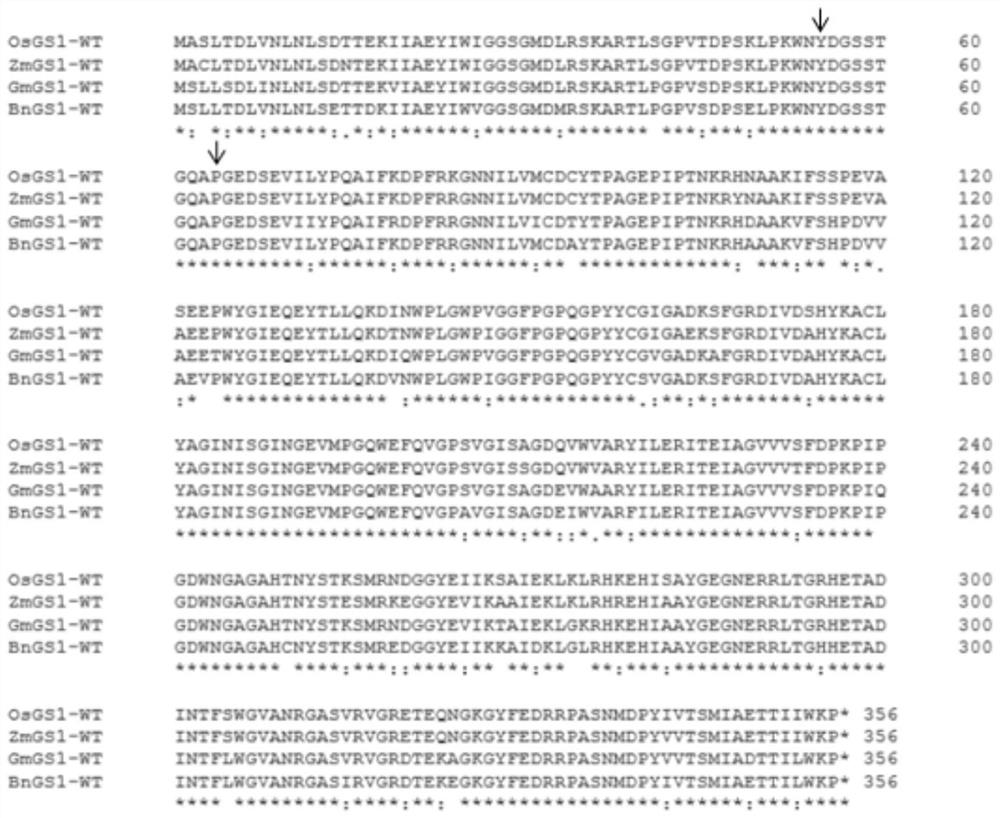Method for obtaining protein with glufosinate-ammonium resistance and glutamine synthetase mutant
A glutamine and synthetase technology, applied in the field of genetic engineering, can solve problems affecting plant growth and development, consumer resistance, and insufficient tolerance for commercial application, etc., to achieve the effect of satisfying growth and development
- Summary
- Abstract
- Description
- Claims
- Application Information
AI Technical Summary
Problems solved by technology
Method used
Image
Examples
Embodiment 1
[0116] The rice (Oryza sativa) glutamine synthase (GS1) mutant provided in this example is obtained from the wild-type rice glutamine synthase itself (named OsGS1-WT, and the amino acid sequence is shown in SEQ ID NO.1, The 55th amino acid residue S of the coding nucleotide sequence of SEQ ID NO. 5) was mutated to D, T, and L, and the obtained rice GS1 mutants were named R55D, R55T, and R55L, respectively.
[0117] The amino acid sequence alignment of rice GS1 mutants R55D, R55T, R55L and wild-type rice GS1 is as follows figure 2 As shown, in the figure: the position indicated by the arrow is the mutation site.
[0118] In this example, the coding sequence of each rice GS1 mutant is at the position encoding the 55th amino acid, the codons used for the corresponding amino acid are shown in the following table, and the nucleotides in the remaining positions are the same as the corresponding wild-type coding sequence.
[0119] amino acid D T L a GAT ACC ...
Embodiment 2
[0122] The soybean (Glycine max) GS1 mutant provided in this example is composed of wild-type soybean GS1 itself (named as GmGS1-WT, the amino acid sequence is shown in SEQ ID NO. 3, and the coding nucleotide sequence is SEQ ID NO. The 55th position of 7) (corresponding to the 55th position of the reference sequence (SEQ ID NO. 1)) was obtained by mutating the amino acid residue S to D. The obtained soybean GS1 mutants were named G55D, respectively.
[0123] The amino acid sequence alignment of soybean GS1 mutant G55D and wild-type soybean GS1 is as follows image 3 As shown, in the figure: the position indicated by the arrow is the mutation site.
[0124] In this example, the coding sequence of each soybean GS1 mutant is at the position encoding the 55th amino acid, and the codons used for the corresponding amino acid are shown in the following table, and the nucleotides in the remaining positions are the same as the corresponding wild-type coding sequence.
[0125] ...
Embodiment 3
[0128] The maize (Zea mays) GS1 mutant provided in this example is composed of wild-type maize GS1 itself (named ZmGS1-WT, the amino acid sequence is shown in SEQ ID NO.2, and the coding nucleotide sequence is SEQ ID NO.6 ) at position 55 (corresponding to position 55 of the reference sequence (SEQ ID NO. 1)) is obtained by mutating the amino acid residue S to D. The resulting maize GS1 mutants were named Z55D, respectively.
[0129] The amino acid sequence alignment of maize GS1 mutant Z55D and wild-type maize GS1 is as follows Figure 4 As shown, in the figure: the position indicated by the arrow is the mutation site.
[0130] In this example, the coding sequence of each maize GS1 mutant is at the position encoding the 55th amino acid, the codons used for the corresponding amino acid are shown in the table below, and the nucleotides in the remaining positions are the same as the corresponding wild-type coding sequence.
[0131] amino acid D a GAT
[...
PUM
| Property | Measurement | Unit |
|---|---|---|
| molecular weight | aaaaa | aaaaa |
| molecular weight | aaaaa | aaaaa |
Abstract
Description
Claims
Application Information
 Login to View More
Login to View More - R&D
- Intellectual Property
- Life Sciences
- Materials
- Tech Scout
- Unparalleled Data Quality
- Higher Quality Content
- 60% Fewer Hallucinations
Browse by: Latest US Patents, China's latest patents, Technical Efficacy Thesaurus, Application Domain, Technology Topic, Popular Technical Reports.
© 2025 PatSnap. All rights reserved.Legal|Privacy policy|Modern Slavery Act Transparency Statement|Sitemap|About US| Contact US: help@patsnap.com



